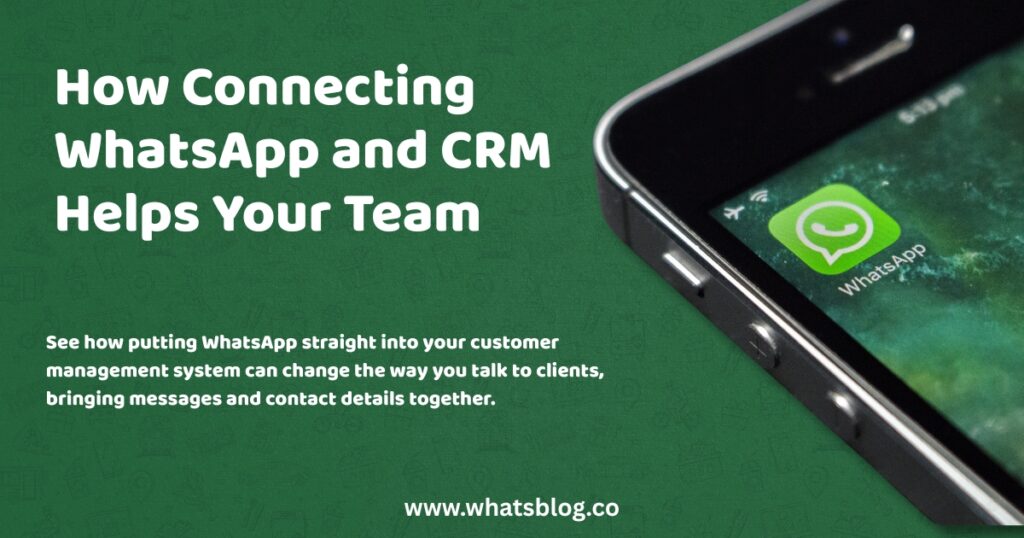Connect WhatsApp and your CRM for better sales
Integrating WhatsApp directly into your Customer Relationship Management (CRM) system can change how you talk to customers.
It brings your most used messaging app and your central customer database together.
This makes communication faster and keeps all interactions in one place, helping your sales and support teams work better.
Why link whatsapp to your crm?
Connecting WhatsApp to your CRM system isn’t just a small tweak; it fundamentally changes customer interaction.
Imagine responding to customer messages almost instantly, right from where you already manage all your customer info. That’s a big win.
It means faster replies and happier customers.
Plus, every single chat, whether it started on WhatsApp, email, or a phone call, gets stored in one neat place in your CRM.
Your whole team sees the same picture. No more digging through different apps to figure out who said what. It makes teamwork smoother and keeps everyone on the same page.
You can also set up automatic messages. Think welcome notes, appointment reminders, or quick updates.
This saves a ton of time and makes sure you’re always in touch, without lifting a finger for every message.
It frees up your team to handle the more complex stuff. Simple. Effective.
How does whatsapp crm integration work?
So, how do you actually make WhatsApp and your CRM talk to each other? There are mainly two ways to go about it.
First, there’s the official route: the WhatsApp Business API. Think of it as the direct line provided by WhatsApp itself.
It’s powerful and meant for medium to larger businesses that handle a lot of messages. Getting access involves an application process, and it gives you a robust way to send and receive messages directly through your CRM or other business software.
It’s the most official and scalable method, but might need some technical setup.
Second, you have third-party integration tools or connectors. These are like bridges built by other companies (like Zapier, Make, or specific platforms built just for this).
They often make connecting WhatsApp to your CRM much easier, sometimes with just a few clicks. These platforms can be a great fit for businesses of all sizes, especially if you want a quicker setup or don’t have a dedicated tech team.
They often add extra features too, like easier ways to manage conversations or build automated flows.
Choosing the right integration method
Okay, you know the options: the official API or a third-party tool. How do you pick?
Think about your business size. If you’re a larger company with lots of customer chats and maybe a tech team, the WhatsApp Business API might be the better long-term bet. It’s built for scale.
But for smaller businesses, or if you want something quick and easy to set up, a third-party connector is often the way to go. Less technical hassle.
Budget matters too. The API has costs associated with sending messages and potentially setup fees depending on how you access it (often via a partner). Third-party tools usually have subscription fees, which might be more predictable month-to-month.
What about tech skills? Setting up the API directly can be complex. If you don’t have technical people on staff, a third-party solution that handles the tricky parts for you is probably smarter.
Finally, check your CRM. Does it already have a built-in WhatsApp connection? Or does it easily link with popular third-party tools like Zapier?
Make sure the method you choose plays nicely with the system you already use.
Popular crms that connect with whatsapp
Lots of CRM systems are getting on board with WhatsApp integration. Some build it right in, others make it easy to connect using those third-party tools we talked about.
Here are a few big names:
- Zoho CRM: Zoho offers WhatsApp integration, letting you manage chats, automate messages using workflows, and use message templates right inside the CRM.
- Salesforce: Salesforce lets you connect WhatsApp through its Service Cloud or Marketing Cloud. This allows for direct messaging, managing conversations as cases, and integrating chats into broader customer service and marketing efforts.
- HubSpot: HubSpot provides WhatsApp integration mainly through the WhatsApp Business API. You can connect it to your conversations inbox, automate messages based on customer actions (like purchases or abandoned carts), and keep chats linked to contact records.
- SAP: For SAP users (like SAP Business One or S/4HANA), integration often happens through partners or specific connectors using the WhatsApp Business API. This lets businesses link WhatsApp chats to customer data and processes within their SAP environment.
Remember, how each CRM integrates can differ. Some might have a direct, native connection, while others rely more on partners or tools like Zapier.
Getting started with whatsapp crm integration
Ready to connect WhatsApp and your CRM? Here’s a rough idea of the steps involved, though the exact process depends on the method and tools you choose.
- Pick Your Path: First, decide if you’re using the official WhatsApp Business API or a third-party integration platform. Base this on your business needs, budget, and tech resources.
- Get API Access (If Needed): If you go the official API route, you’ll likely need to apply for access. This often involves working with a WhatsApp Business Solution Provider (BSP) or using Meta’s Cloud API setup.
- Configure the Connection: Follow the instructions provided by your CRM or the third-party tool. This usually involves linking your WhatsApp Business account number and authorizing the connection. It might mean copying an API key or just logging in.
- Set Up Templates: With the API, WhatsApp requires pre-approved message templates for initiating conversations with customers (like notifications or reminders). You’ll need to create and get these approved.
- Map Fields & Workflows: Tell the system how you want things to work. For example, should a new WhatsApp chat create a new contact in the CRM? Should incoming messages trigger specific automated responses?
- Test, Test, Test: Before going live, send test messages back and forth. Make sure everything works as expected – messages send and receive correctly, contacts sync, and automations fire properly.
It might seem like a few steps, but taking it one stage at a time makes the process manageable.



